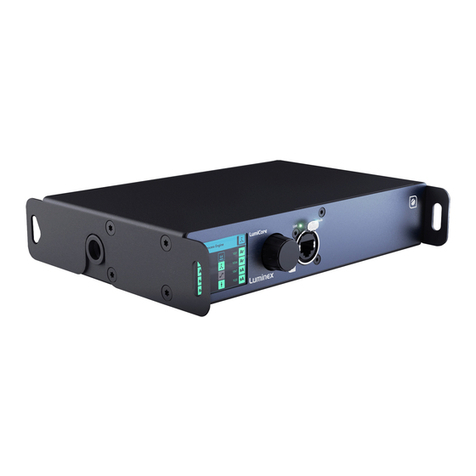
2.2 Groups (VLANs)
The groups function allows the user to segment the network into sev-
eral virtual networks (VLANs). The main benefit of this function is that
no group will affect the other ones, on protocol level.
The user can create several groups on the network, and each device
included in a group will be able to communicate with devices in this
group only. This will result in a better bandwidth, and no protocol con-
flict.
Three groups have been created in the illustration to the right: Red,
Green and Blue. Each device included in each group can communi-
cate with devices from the same group. Thus, the sound console and
the sound processor can talk to each other, without being flooded by
packets streamed by the two other groups.
The GigaCore switches offer 20 groups, to which the user can assign
any of the ports. Two devices must be part of the same group to com-
municate.
When more than one switch is used in a group-based network, the
Inter Switch Link group (ISL Group 0) must be used to forward the
group’s packages between switches.
2.3 MultiLinkX:
Most of the time, a redundant link set with RLinkX between two Gi-
gaCore switches will be good for the everyday event. A 1000Mbps link
is more than enough for most of the current applications. However,
it can happen that you’ll need to transfer a larger amount of data be-
tween the switches.
For example four video transmitters are transmitting four video
streams to each dedicated receiver. Each stream requires a throughput
of 400Mbps, which represents 1600Mbps in total.
However, only one link is active between the switches, as the oth-
er link is used as redundant link. So, a maximum of 1000Mbps data
transfer can be achieved on this link. In the above example, we need
1600Mbps of throughput to transfer all four video streams between
the switches.
This is not enough, the link between the switches will create a bottle-
neck, resulting in data loss or data delay. The video streams won’t be
delivered in time and will create lag in the video output.
The solution? MulitiLinkX!
MultiLinkx enables you to gather several links together and turn them
into one virtual link (link aggregation). This provides you with more
bandwidth between the switches, and thus more throughput. Multi-
LinkX can accept a maximum of 16 ports per aggregation, and up to 8
aggregations can be created on a switch.
Light Over IP Converter
Light Over IP Console
Sound Over IP Processor
Sound Over IP Console
Video Over IP Out
Video Over IP Out
Inter Switch Links (ISL)
Rx: 400Mbps
Tx: 400Mbps
Rx: 400Mbps
Tx: 400Mbps Tx: 400Mbps
1000Mbps
Rx: 400Mbps Rx: 400Mbps
Tx: 400Mbps
Rx: 400Mbps Rx: 400Mbps Rx: 400Mbps Rx: 400Mbps
Tx: 400Mbps Tx: 400Mbps Tx: 400Mbps
1000Mbps
+1000Mbps
Tx: 400Mbps
10
2 | GIGACORE FEATURES EXPLAINED / 2.2 GROUPS / 2.3 MULTILINKX





























